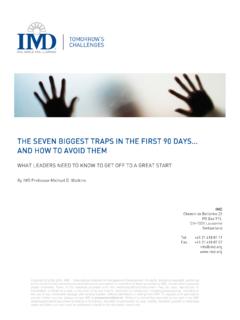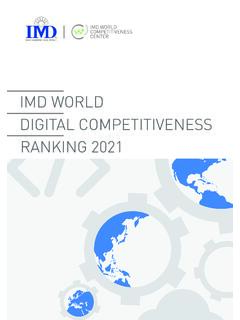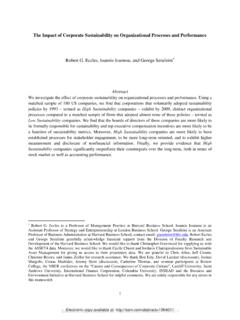Transcription of A PRACTICAL PERSPECTIVE: STEWARDSHIP
1 A PRACTICAL perspective : STEWARDSHIP . FOSTERING RESPONSIBLE. LONG-TERM WEALTH CREATION. PUBLISHED BY IMD (2015). Introduction: STEWARDSHIP in a nutshell How can a business thrive and sustain growth while enhancing the wealth of its stakeholders and the well-being of the societies in which it operates? This, in essence, is the question STEWARDSHIP aims to answer. The landscape for business is ever evolving. Business structures and relationships PROF. among stakeholders are becoming more complex and interdependent. Businesses DR. DIDIER COSSIN face unrelenting short-term pressures when making decisions.
2 Corporate governance practices are reevaluated after every financial crisis, but often move in the direction of increasing guidelines and regulations. Such corporate governance measures are helpful and often necessary. However, sound steward- ship has a longer term and wider view, with a motivation that extends beyond a comply or explain mentality. In short, the STEWARDSHIP question needs to be considered from a perspective that includes, but goes beyond, merely complying with corporate governance require- ments or seeking short-term benefits solely for a specific group of people, namely BOON HWEE ONG.
3 The shareholders . This concept paper seeks to define and to engender a discussion on STEWARDSHIP and its landscape. This landscape comprises various key players, whose actions and interactions have impact and implications for sustainable wealth creation across organizations and communities. With this paper, we hope to contribute towards enhancing the understanding and fostering of STEWARDSHIP for corpora- tions and business leaders across the world. Building on existing theories and factoring in PRACTICAL considerations of business, we define STEWARDSHIP as an inclusive and holistic approach.
4 STEWARDSHIP has the SOPHIE COUGHLAN following dimensions: a clear sense of purpose, an intertemporal horizon and the engagement of different stakeholders. STEWARDSHIP leaders take action that is characterized by the combination of three seminal attributes: leading with impact, safeguarding the future, and driving social good. The concept paper examines a number of vital questions: Who are the key players? How are they linked in a STEWARDSHIP ecosystem? What are the processes by which companies can best achieve STEWARDSHIP solutions through the relationship between and amongst key internal and external agents?
5 Do the different agents each play unique roles within the STEWARDSHIP landscape? (These players not only include shareholders , the board of directors, the chief executive, management and employees but also extend to society and beyond.). Does STEWARDSHIP depend on context or is there a universal approach to STEWARDSHIP ? While contexts may vary, are there characteristics that are common to well-stewarded companies that thrive over a long period? Do differences in cultural traits and situational contexts influence the occur- rence of STEWARDSHIP ?
6 What factors in particular support steward leaders in staying true to their purpose? Do organizational contexts help to bring about STEWARDSHIP ? What part does governance play in fostering effective STEWARDSHIP ? For sound governance to result, what are the roles that the key players in the system need to fulfill? With the emergence of large institutional investors adding complexity to the landscape, how do they influence STEWARDSHIP situations and outcomes? What roles could they play? How could investors and companies efficiently engage in conversations so as to better align their long-term goals?
7 Is the establishment of STEWARDSHIP codes useful and effective in engaging share- holders and facilitating responsible interaction? How can governments play a key role in providing a stable and predictable operating framework for STEWARDSHIP to thrive? How could the regulatory framework be calibrated to have the desired effect without jeopardizing the business agility and motivation necessary to deliver sustainable wealth creation? Through an awareness of the STEWARDSHIP ecosystem and the factors at play, firms can better understand how to steer wealth creation in the context in which they operate.
8 Steward leaders need the courage to chart their firm's path based on their own values and culture, so as to exert a positive influence towards the longer term and a more impactful outcome sacrificing the shorter term where required. With a clear sense of purpose, STEWARDSHIP enables companies to ensure that their success is sustainable and contributes to their future prosperity as well as the well-being of society at large. 2 - A PRACTICAL perspective : STEWARDHSIP. 1) Why: STEWARDSHIP matters How can a business contribute to the wealth and well-being of the societies where it operates over the long term?
9 The role and responsibility of business in society has long been a topic of discussion and study. A renewed focus on this after each financial crisis reflects an underlying question: What are the boundaries of busi- ness responsibility beyond wealth creation? Viewpoints abound. Much past discus- sion can be positioned on a continuum with shareholder primacy at one extreme and stakeholder theory at the other. In nations where the state plays a more active part in the business sphere, the situation can differ. With the growing affluence and influence of sovereign wealth funds (SWFs) in many countries, there is the potential for the various players in the economic sphere to work together for long-term wealth creation and the benefits of the wider community (see Section 5).
10 The best way for businesses to contribute constructively is to maximize their sustained wealth creation capability and to have a sense of responsibility towards the com- munity at large to do well so as to be able to do good in a broader societal sense. While many have suggested the need for a long-term perspective , business leaders continue to face short-term pressures. Such pressures place them squarely and continually at the center of dilemmas -- making daily decisions about trade-offs. What can be done to engender the right set of circumstances to allow leaders to take a longer term, more holistic perspective ?










